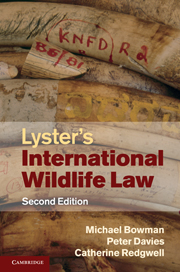Book contents
- Frontmatter
- Contents
- Foreword
- Preface
- List of abbreviations
- PART I Foundations of international wildlife law
- PART II Species regulation
- PART III Regional wildlife regulation
- 8 The Convention on Nature Protection and Wildlife Preservation in the Western Hemisphere
- 9 The African Convention on the Conservation of Nature and Natural Resources
- 10 The Convention on the Conservation of European Wildlife and Natural Habitats
- 11 Polar regions
- 12 Other regional and subregional arrangements
- PART IV Global wildlife regulation
- PART V Biological diversity: a new perspective on wildlife regulation
- PART VI Cross-sectoral issues in wildlife regulation
- PART VII Conclusion
- Index
- References
8 - The Convention on Nature Protection and Wildlife Preservation in the Western Hemisphere
Published online by Cambridge University Press: 05 July 2011
- Frontmatter
- Contents
- Foreword
- Preface
- List of abbreviations
- PART I Foundations of international wildlife law
- PART II Species regulation
- PART III Regional wildlife regulation
- 8 The Convention on Nature Protection and Wildlife Preservation in the Western Hemisphere
- 9 The African Convention on the Conservation of Nature and Natural Resources
- 10 The Convention on the Conservation of European Wildlife and Natural Habitats
- 11 Polar regions
- 12 Other regional and subregional arrangements
- PART IV Global wildlife regulation
- PART V Biological diversity: a new perspective on wildlife regulation
- PART VI Cross-sectoral issues in wildlife regulation
- PART VII Conclusion
- Index
- References
Summary
Background
In December 1938 the Eighth International Conference of American States met in Lima and recommended that the Pan American Union establish a committee of experts to study problems relating to nature and wildlife in the American republics and prepare a draft convention for their protection. Pursuant to this recommendation, the Convention on Nature Protection and Wildlife Preservation in the Western Hemisphere (the Western Hemisphere Convention) was concluded and opened for signature to member states of the Pan American Union (now the Organization of American States, and hereinafter referred to as the OAS) on 12 October 1940. It entered into force on 30 April 1942. It has been signed by twenty-two member states of the OAS and ratified by nineteen of them, the last ratification being that by Suriname in 1985.
The Western Hemisphere Convention was a visionary instrument, well ahead of its time in terms of the concepts it espouses. The protection of species from human-induced extinction, the establishment of protected areas, the regulation of international trade in wildlife, special measures for migratory birds and stressing the need for co-operation in scientific research and other fields are all elements of wildlife conservation which are covered by the Convention – many of them for the first time by an international treaty – and which have reappeared time and again in other conventions concluded since 1940.
- Type
- Chapter
- Information
- Lyster's International Wildlife Law , pp. 241 - 261Publisher: Cambridge University PressPrint publication year: 2010



